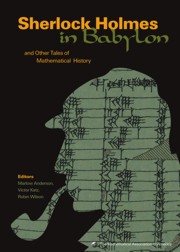Book contents
- Frontmatter
- Introduction
- Contents
- Ancient Mathematics
- Medieval and Renaissance Mathematics
- The Seventeenth Century
- Foreword
- An Application of Geography to Mathematics: History of the Integral of the Secant
- Some Historical Notes on the Cycloid
- Descartes and Problem-Solving
- René Descartes' Curve-Drawing Devices: Experiments in the Relations Between Mechanical Motion and Symbolic Language
- Certain Mathematical Achievements of James Gregory
- The Changing Concept of Change: The Derivative from Fermat to Weierstrass
- The Crooked Made Straight: Roberval and Newton on Tangents
- On the Discovery of the Logarithmic Series and Its Development in England up to Cotes
- Isaac Newton: Man, Myth, and Mathematics
- Reading the Master: Newton and the Birth of Celestial Mechanics
- Newton as an Originator of Polar Coordinates
- Newton's Method for Resolving Affected Equations
- A Contribution of Leibniz to the History of Complex Numbers
- Functions of a Curve: Leibniz's Original Notion of Functions and Its Meaning for the Parabola
- Afterword
- The Eighteenth Century
- Index
- About the Editors
Newton's Method for Resolving Affected Equations
from The Seventeenth Century
- Frontmatter
- Introduction
- Contents
- Ancient Mathematics
- Medieval and Renaissance Mathematics
- The Seventeenth Century
- Foreword
- An Application of Geography to Mathematics: History of the Integral of the Secant
- Some Historical Notes on the Cycloid
- Descartes and Problem-Solving
- René Descartes' Curve-Drawing Devices: Experiments in the Relations Between Mechanical Motion and Symbolic Language
- Certain Mathematical Achievements of James Gregory
- The Changing Concept of Change: The Derivative from Fermat to Weierstrass
- The Crooked Made Straight: Roberval and Newton on Tangents
- On the Discovery of the Logarithmic Series and Its Development in England up to Cotes
- Isaac Newton: Man, Myth, and Mathematics
- Reading the Master: Newton and the Birth of Celestial Mechanics
- Newton as an Originator of Polar Coordinates
- Newton's Method for Resolving Affected Equations
- A Contribution of Leibniz to the History of Complex Numbers
- Functions of a Curve: Leibniz's Original Notion of Functions and Its Meaning for the Parabola
- Afterword
- The Eighteenth Century
- Index
- About the Editors
Summary
During the 300 years since Newton and Leibniz began disputing which of them had discovered the calculus, debates have continued over the credit due to Newton for various scientific and mathematical achievements. Recent research by Nick Kollerstrom [11] has led him to credit Thomas Simpson (1710–1761) with the first discovery and publication in 1740 [18] of what is now called Newton's method. William Dunham [8] has pointed out the irony that Newton, who “bitterly resented people's getting credit for results they did not originally discover,” is credited with a method of approximation that “in its full generality seems to be due to” Simpson.
The debate over priority for Newton's method may now be settled, but almost forgotten in the discussion is that Newton presented his method for approximating real roots side by side with a similar method for writing y in terms of x when y is implicitly defined in terms of x by a polynomial equation—a so-called “affected equation.” This second “Newton's method” is an important tool in modern algebraic geometry and, although it is more subtle than his method for approximating roots, it can be understood by precalculus students.
Richard S. Westfall [22] highlights how Newton used his method for resolving affected equations to integrate algebraic equations:
… in the mid-1660s, Newton was working toward a general method of squaring curves, as they put it then; let us say “integration” for simplicity.
- Type
- Chapter
- Information
- Sherlock Holmes in BabylonAnd Other Tales of Mathematical History, pp. 279 - 287Publisher: Mathematical Association of AmericaPrint publication year: 2003



